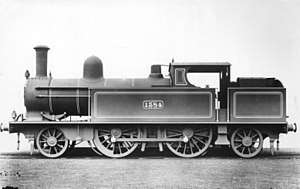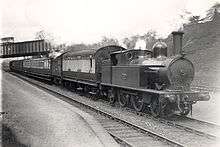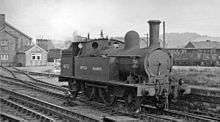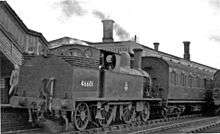LNWR 5ft 6in Tank Class
The LNWR 5ft 6in Tank was a class of 160 passenger 2-4-2T locomotives manufactured by the London and North Western Railway in their Crewe Works between 1890 and 1897. The "5ft 6in" in the title referred to the diameter of the driving wheels – although the stated dimension was for the wheel centres – the nominal diameter including the tyres was 5 ft 8 1⁄2 in (1,740 mm).
| LNWR 5ft 6in Tank class | |||||||||||||||||||||||||||||||||||||
|---|---|---|---|---|---|---|---|---|---|---|---|---|---|---|---|---|---|---|---|---|---|---|---|---|---|---|---|---|---|---|---|---|---|---|---|---|---|
 No. 1384 As built, photographic grey livery | |||||||||||||||||||||||||||||||||||||
| |||||||||||||||||||||||||||||||||||||
| |||||||||||||||||||||||||||||||||||||
| |||||||||||||||||||||||||||||||||||||
Design
The design featured a boiler pressed to 150 lbf/in2 (1.03 MPa) delivering saturated steam to two 17 by 24 inches (430 by 610 mm) cylinders connected by Joy valve gear to the driving wheels.
They were effectively a tank version of the LNWR Webb Precursor Class[1], which were then being withdrawn.
Service
Three locomotives were withdrawn before the 1923 Grouping; the remaining 157 locomotive passed to the London, Midland and Scottish Railway who renumbered them 6600–6757, and gave them power classification 1P.
Forty-two locomotives were fitted up between 1929 and 1932 by the LMS for push-pull train service.[2]
Two were sold to the War Department in 1930 and 1931; they served on the Longmoor Military Railway where they were became LMR 22 Earl Haig and LMR 23 Earl Roberts.[3]. No. 22 was scrapped circa 1939, No. 23 lasted long enough to be renumbered WD 206, but was scrapped during the war.[4]
Forty-three survived to BR service in 1948, BR numbers were the same as LMS plus 40000. The last was withdrawn in September 1955 and none were preserved.
 LNWR era shot, posed for the camera
LNWR era shot, posed for the camera LMS Livery
LMS Livery Early BR livery with "BRITISH RAILWAYS" lettering
Early BR livery with "BRITISH RAILWAYS" lettering BR livery
BR livery
References
- http://www.lnwrs.org.uk/PassClassLocos/pass_class_menu.php?display_class_details=w56t
- Baxter 1979, pp. 210–213.
- Baxter 1979, p. 211.
- Tourret 1995, p. 149.
- Baxter, Bertram (1979). Baxter, David (ed.). British Locomotive Catalogue 1825–1923, Volume 2B: London and North Western Railway and its constituent companies. Ashbourne, Derbyshire: Moorland Publishing Company. pp. 210–213. ISBN 0-903485-84-2.
- Casserley, H. C. & Johnston, Stuart W. (1974) [1966]. Locomotives at the Grouping 3: London, Midland and Scottish Railway. Shepperton, Surrey: Ian Allan. pp. 74–75. ISBN 0-7110-0554-0.
- Tourret, R. (1995). Allied Military Locomotives of the Second World War. Abingdon, Oxon: Tourret Publishing. ISBN 0-905878-06-X.